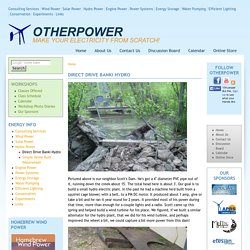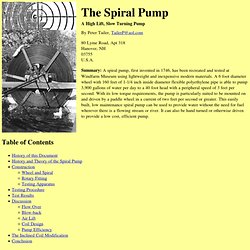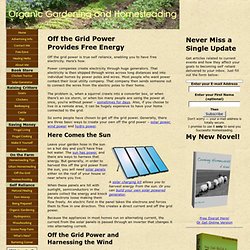

DIY Solar Projects Part 1: Build a Solar Heater Using Recycled Cans. A few months ago we did an article about Cansolair Inc’s brilliant solar home heating solution that uses recycled aluminum cans in a forced convection solar heating unit.

These units work by pulling cool air from a room, passing it through a panel of aluminum cans that are heated by the sun, and blowing the heated air back into the room. Just about anyone can make one of these heaters, and they can be constructed from mostly recycled materials. This is a fairly simple project for DIY’ers that can be used to heat a home, a greenhouse, a camper, a garage, a cabin, or just about anything else you can think of. Once the unit is built, all you need is an outside wall for it to sit against that will get plenty of sun. As long as the sun is shining, you will have free heat with little to no maintenance costs. Comments comments. Direct Drive Banki Hydro.
Pictured above is our neighbor Scott's Dam.

He's got a 4" diameter PVC pipe out of it, running down the creek about 15'. The total head here is about 3'. Our goal is to build a small hydro electric plant. In the past he had a machine he'd built from a squirrel cage blower, with a belt, to a PM DC motor. It produced about 1 amp, give or take a bit and he ran it year round for 2 years. We started with scraps of sheet metal and angle iron. The Vanes in the runner are made from quartered 4" diameter steel conduit.
The sides of the runner are 12" diameter. The template is glued to one of the disks which make up the sides of the runner, and we have both disks clamped together. We put 10" between the two sides of the runner using allthread, and squared it up as best we could before installing the vanes. Here the runner is getting welded up. Pictured above the runner is pretty well tacked together. Pictured above it's starting to take shape. 507 Mechanical Movements, 118. Solar Photovoltaic Projects. Photovoltaic (PV) solar electricity systems have captured a lot of interest as the system components have grown more mature, capable, and reliable.
The references and articles below provide PV system basics, examples of the four common types of PV systems used to generate electric power, reviews of PV system components, lots on how-to build your own PV system, and a few interesting "other" PV systems. Contrary to popular belief, in most areas it is perfectly legal and relatively straight forward to do your own PV -- we did...
Directory for the PV section: Be sure to do the Solar Site Survey to make sure that your PV panels will have an unobstructed sun for the critical part of the day. The survey should be done from the location where the PV panels will be mounted. PV powered water pumping systems are covered under Solar Water Pumping PV power vehicles are here.
NEW -- Our new micro-inverter, off-grid PV system... Questions? The Spiral Pump: A High Lift, Slow Turning Pump. Table of Contents History of this Document First distribution 1986.

Additions 1998 and 1990. OCR scan and conversion to HTML by Chris Pirazzi, chris@pirazzi.net, 2005. Please report any typos or errors to both chris@pirazzi.net and TailerP@aol.com. Internet address of this document: There are other interesting documents about water-powered water pumps at: which readers of this document may also find interesting. History and Theory of the Spiral Pump In some instances, records of preindustrial technology can be a source of concepts which can be updated with modern materials and modified to be utilized in today's technology transfer efforts. Wirtz invented the spiral pump to provide water for a dye works just outside of Zurich. The Wirtz spiral pump was constructed so the end of the outside pipe coil opened into a scoop. Figure 1: Historic Wirtz Pump—1842 drawing Figure 2: Historic Wirtz Pump—1842 drawing Since first completing this report, two projects came to our attention.
Construction. Off the Grid Power Provides Free Energy. Off the grid power is true self reliance, enabling you to have free electricity.

Here's how. Power companies create electricity through huge generators. That electricity is then shipped through wires across long distances and into individual homes by power poles and wires. Most people who want power contact their local utility company. That company then sends someone out to connect the wires from the electric poles to their home. The problem is, when a squirrel crawls into a converter box, or when there’s an ice storm, or when too many people are using the power at once, you're without power – sometimes for days. So some people have chosen to get off the grid power.